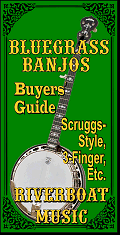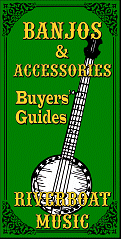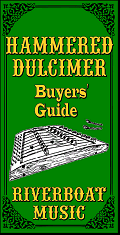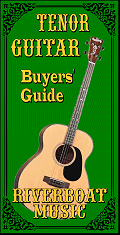Acoustic Instrument
Primers
What Kind of Guitar
Should I Start On?
What Kind of Banjo
Do I Want?
Evaluating and
Buying Used
Guitars
Setting Up
Fretted Instruments Whatever Happened
to the Banjo?
Beginning Five-
String Banjo
6-String Banjos
Banjo Pickups
Axes in my Life
What is a
Bluegrass Banjo?
Dean "Backwoods
Six" Shootout
Music Theory
Primers
Introduction
to Scales
Introduction
to Chords
Circle of Fifths
Other Articles
About Music
How to Give
Guitar Lessons
Musician or
Wannabe? Did God Really
Give Rock &
Roll to You?
Are You a
"Brand Bigot"?
Who Owns Folk Songs?
Historical Links
About the
National Road
The Story Behind
the Story - Real
People, Places,
and Events
About the Play
Play Home
What's New
Overview
About the
Music
About the
History
About the
Logistics
About the
Cast
Synopsis
About the
Set
About the
Author
Contact Us
Home




|



Beginning Five-String Folk Banjo - Part Two - Introduction to Banjo Rolls
| Written by Paul Race for Creek Don't RiseTM and School Of The RockTM |
This is a follow-up to our article "Introduction to Banjo Chords." We are talking exclusively about 5-string banjo here. Four-string and six-string banjos may be played many ways, but the 5-string can do certain things that they can't. So that's what we're focusing on in this article series.
In addition, some techniques call for you to pick downward, even on individual strings for the melody or bass lines.
The name "roll" may come from the drum - certain patterns on the snare drum are the starting point for everything you'll ever do on a drum kit. Until you can play your banjo roll(s) while holding an intelligent conversation or reading Dickens with comprehension, you'll never progress to the "next level."
The lower set of lines represents the neck of a five-string banjo tuned to the most common Bluegrass tuning (G,B,G,D,high G). This is a kind of "tabulature."
In this illustration, the little zeroes show that none of the strings are fretted - you've given your left hand a break, and you're doing every thing with the thumb and fingers of your right hand. You'll see that each little zero is exactly below one of the notes in the staff. That's our way of showing you the rythms you should be playing. (There are kinds of tabulature that have more information on the tab line, but my software won't generate them.)
There are several ways to play the same roll, using different fingers for different strings - we'll get into that presently. But the notes being played are almost the same, so banjo tabulature crosses playing styles pretty well
I'm not going to tell you which right-hand technique to choose. If you have a favorite banjo player or favorite songs, you might do best by finding a teacher that can teach the technique that player or song uses.
There are also other kinds of "rolls," ones that hit the strings in different sequences. That said, most of them hit either the bass or the melody note on the first beat, so a 5-string picker used to one kind of roll can often play solos that are traditionally played with another kind of roll.
For my part in this article, I try to keep my tabulature simple enough to work with most of the basic styles, and I trust you to make any accommodations you need to.
For a simple measure like that shown in the tab above, they almost serve the same purpose. They both show that strings 1, 4, and 5 are played "open" (not fretted), and that strings 2 and 3 are fretted on the first and third fret, respectively. In fact, if you play the chord shown in the chord chart with your left hand and just use the picking pattern shown in the tab, you'll find all the notes exactly where you need them to be.
On the other hand, the tab shows the notes being played at different times, something you can't really show with chord charts. And in more advanced tabs, you'll see other notes that aren't, technically, part of the chord. So if there is a chord chart, and it shows the right chord in the right position (not always a given in published music), you might could use it as a sort of starting point for the fingers of your left hand. But the tab will always have more information, one way or anohter.
Three-Finger Picking
In the example above right, you would use your index finger to pick the first note of the pattern, your middle finger to play the second note, and your thumb to play the third note. Then you would start all over again with your index finger. Some 3-finger pickers do double-duty with their thumb, using it to hit low strings as well as higher strings. My thumb has never moved that fast. But it's just another acquired skill, I suppose. For more information about Three-Finger Picking, check out our article "What is Three-Finger Picking?.
One of the most common variations includes picking the melody or bass notes downward with your index or middle finger, instad of plucking the string as you would in Bluegrass banjo. In this version the main thing your thumb is used for is hitting the high G string at the end of the pattern. In the graphic to the right:
One major difference in the sound that you hit more strings on beats 2 and 4 than Bluegrass players do. Some folks find getting precise on this technique hard - don't get me wrong - but the results are loud, especially if you strum most or all of the strings on beats 2 and 4. So loud, in fact, that a lot of folk who use this technique actually avoid banjos with tone rings and resonators.
The technique and related ones I'll explain in a minute are much older than "Scruggs picking." They were favored by Folk Revival banjo players like Pete Seeger and "Old-Timey" pickers like Grandpa Jones. Another version of this has you picking the first and third beat with your index finger or thumb. The index-finger version is shown right. When I want to play something approaching a "frailing" style this is what I do.
The thumb version (called "drop thumb" picking) is shown below.
Difference Between Frailing and Clawhammer? There are almost as many variations in this class of techniques are there are players. To some purists, a clawhammer player never plucks a string upward, while a "frailer" may use a mix of plucking and strumming. While it's pretty easy to hear the difference between this class of techniques and three-finger-picking, it's hard to hear the difference between some of the variations. You can get into religious arguments in a hurry. In fact, there were flame wars over it in the 1990s. Ignore them. Find a technique that works for you and get so good you put the haters to shame.
Drop-Thumb Picking: Some folks use their thumb to do "double-duty" on this sort of pattern. One version if this "drop thumb" playing is shown to the right.
Four-Finger Picking
I probably shouldn't add this, because haters come out of the woodwork whenever I do. But I will. I dabbled in classical guitar before I came to 5-string as a 16-year old in a town that knew nothing of traditional or Bluegrass banjo playing. The books I used Used to four-finger picking on guitar, I settled on a variation of 3-finger picking. Except that I also use my ring finger. In the graphic to the right, "R" stands for ring finger. If you compare this to the first three-finger-picking roll on the page, you'll see that the only difference is that I'm playing two notes on beats 2 and 4 instead of one. I think the additional tone makes the roll sound more like traditional playing. At the same time, this allows me to go into 3-finger picking in a heartbeat when I need to. Who are the banjo players you'd most like to emulate? Now figure out what techniques they use, and find a teacher who can teach you that technique. Or if, like I was as a kid in the 1960s, you live in a "vast wasteland," try the different techniques on this page and see what you think sounds the best. Then get so good on banjo that when someone tell you you're doing it "wrong," you can just blow them off. The proof is in the playing.
On the other hand, nothing is gained if you don't start playing actual songs soon.
Let's go back to our first two songs and play a bum-ditty pattern to each of them. By now you should be able to go back and forth between those three chords pretty well. Now it's time to start making your banjo playing sound like banjo playing. We won't add the melody until later, but you can start accompanying yourself on banjo this minute.
Rather than take up room on this page, I have pdf sheet music that will show you the melody and a simple "bum-ditty" banjo accompaniment part for each of the two songs we've used so far. We don't include the little letters under the staff to show you which fingers to use - that will depend on which technique you are practicing. Also, most of my tabs show multiple notes being played at the same time on beats 2 and 4. If you're trying to learn three-finger picking, just play the highest note on those beats for now.
There are about a million songs you can sing with just these three chords and the rolls shown on this page. Here are a few. You're on your own, figuring out which chords go where.
Some of these songs will sound funny on a banjo at first. Play them until they sound like they were written for banjo. Sing the ones that are in your range until they sound like they were written for you. :-)
By the way, most banjo players, historically, have used the instrument to accompany their singing. So practice singing, too. Think about it - how many guitar players do you see go up to open mics and just play guitar? Yet a lot of modern banjo players (and even some teachers) seem to think that the only purpose for picking up a banjo is to blow people away with your technique. If that's your agenda, it'll be years before you're confident enough in what you do to take your banjo to parties or jams. Instead, work on the "whole package." While you're still struggling with getting the rolls down, try singing songs you know. It will also help you work on your timing. As a sometime teacher, I've known too many would-be banjo or guitar players who could play an instrumental part smoothly, as long as they weren't also singing. What's the future in that?
As much as I like banjo and guitar and mandolin and dulcimer, etc. I don't think you can develop as a well-rounded musician if your entire focus is what you can do from the wrist on down.
5-String Banjo Picking is Different from Guitar Picking
While you occasionally see someone picking a 5-string banjo's strings with a flat-pick, the standard practice in North America is to pick the strings with the individual fingers of your right hand. Unlike fingerpicking guitar, on which your thumb usually hangs out on the lowest notes, your thumb has to be free to pick the highest note. That's the fifth string - the short one closest to your chin, if you're playing right-handed. That means that your index finger will likely take over some, if not all, of the responsibilities your thumb handles on guitar.
Banjo Rolls
Right-hand technique for five-string banjo centers around two or four-beat patterns called "rolls. Beginners often get frustrated because their teachers insist that they start by learning a roll so well they can do it in their sleep. But that roll is like the plain Lego blocks that come in every set. They're not as exciting as windows or little figures, but you'll have trouble making a building without a lot of those identical little components.
 The roll I use most often produces a "bum-ditty" pattern. This is illustrated in the little picture to the right. The top set of lines is regular notation so you can see the rythm that I'm talking about. If you're a purist, you'll notice that the notes are shown an octave higher than they actually sound. But this way I can fit the notes on a single staff, which makes both printing and reading the parts easier.
The roll I use most often produces a "bum-ditty" pattern. This is illustrated in the little picture to the right. The top set of lines is regular notation so you can see the rythm that I'm talking about. If you're a purist, you'll notice that the notes are shown an octave higher than they actually sound. But this way I can fit the notes on a single staff, which makes both printing and reading the parts easier. 
 Once you get the hang of this, you can add an "alternating bass." On a G chord, that means that you go back and forth between G and D. Beats two and four stay the same. Later on, you'll learn to play simple melodies just by changing which notes you hit on beats 1 and 3.
Once you get the hang of this, you can add an "alternating bass." On a G chord, that means that you go back and forth between G and D. Beats two and four stay the same. Later on, you'll learn to play simple melodies just by changing which notes you hit on beats 1 and 3. 
Reading 5-String Banjo Tabulature
As you've probably picked up by now, the five-string banjo has four strings you may or may not fret, and one string you usually don't. If your banjo is tuned to the most common tuning, and you lay it in your lap and start with the farthest string out, the notes are D, the B below that, the G below that, and the D below that, and a G that's higher than the the first string. In fact, if you fret the first string at the fifth fret, it should be the same as the fifth string unfretted.
 When you see a number, that means that you are to play that string with it fretted string at that fret. If you don't actually fret a string at all, the number is zero, like it is in the illustration above. In the illustration to your right, the number "1" on the second string means that you put your finger down just behind the first fret on the second string, holding the string hard enough that it doesn't buzz. If you look at the music staff above, you'll see that you're playing a "C" note. The "D" note that's crammed onto the same staff is the first string, which is open (not fretted). The fact that the numbers are stacked on top of each other on the fret lines means that you play them both at once. Again, the music staff above gives those of you who read a little music a sense of what the rythm should be.
When you see a number, that means that you are to play that string with it fretted string at that fret. If you don't actually fret a string at all, the number is zero, like it is in the illustration above. In the illustration to your right, the number "1" on the second string means that you put your finger down just behind the first fret on the second string, holding the string hard enough that it doesn't buzz. If you look at the music staff above, you'll see that you're playing a "C" note. The "D" note that's crammed onto the same staff is the first string, which is open (not fretted). The fact that the numbers are stacked on top of each other on the fret lines means that you play them both at once. Again, the music staff above gives those of you who read a little music a sense of what the rythm should be.
Tab Versus Chord charts
 Remember our D7sus4 chord chart from the previous lesson. We're putting it here so you can compare it to the tabulature above. Of course the big difference is that in a chord chart, the strings go up and down, and in a tabulature they run from left to right. But you can see they contain much of the same information.
Remember our D7sus4 chord chart from the previous lesson. We're putting it here so you can compare it to the tabulature above. Of course the big difference is that in a chord chart, the strings go up and down, and in a tabulature they run from left to right. But you can see they contain much of the same information.
Choosing a Right-Hand Technique
As I mentioned above, there are any number of ways to allocate your right-hand fingers to pick certain strings or to play on certain beats or both. Folks who write banjo books often indicate which finger you should use by sticking little letters under the staff.
 The graphic to the right shows a version of the roll pattern shown above as a Bluegrass picker might play it. When you say Bluegrass, most people really mean Earl Scruggs, who popularized the 3-finger picking style. Earl would "nail" the pinky and ring finger of his right hand onto the head of the banjo and do all his work with three fingers.
The graphic to the right shows a version of the roll pattern shown above as a Bluegrass picker might play it. When you say Bluegrass, most people really mean Earl Scruggs, who popularized the 3-finger picking style. Earl would "nail" the pinky and ring finger of his right hand onto the head of the banjo and do all his work with three fingers.



Frailing or Clawhammer-Related Styles
The most common other group of right-hand techniques has a number of names and variations, but it involves using the back if your fingernails to strum downward, especially on beats 2 and 4.



 Other folks call all of these variations "clawhammer."
Other folks call all of these variations "clawhammer."
 (especially Pete Seeger's How To Play The 5-String Banjo
(especially Pete Seeger's How To Play The 5-String Banjo,
showed a number of different techniques. Silly me, I thought that finding a technique that worked for me and getting good on the instrument was all I needed to do.

 As another example, I find the sort of arpeggio I showed above in a three-finger picking example easier to do with four-finger picking.
As another example, I find the sort of arpeggio I showed above in a three-finger picking example easier to do with four-finger picking. 
Which Technique Should You Use?
Although lots of folks dabble in several techniques, the one you start with will probably be the one you get the most use out of from now on. So you might as well start out with a technique that will best satisfy your idea of what a banjo should sound like.
Moving Forward
As you can see, there are several different ways to play more-or-less the same part. So start somewhere. If you decide later that you'd rather be frailing than three-finger picking or vice versa, nothing is lost.
Conclusion
Play these songs until you can play them in your sleep or hold up your end of an intelligent conversation, without skipping a beat. Practice singing them, too, while you're at it.
All material, illustrations, and content of this web site is copyrighted © 2001, 2002, 2003, 2004, 2005, 2006,
2007, 2008, 2009, 2010, 2011, 2012, 2013, 2014, 2015 by Paul D. Race. All rights reserved.
Creek Dont' Rise(tm) is a participant in the Amazon Services LLC Associates Program, an affiliate advertising
program designed to provide a means for sites to earn advertising fees by advertising and linking to Amazon.com.
For questions, comments, suggestions, trouble reports, etc. about this play or about this web page, please contact us.
| Visit related pages and affiliated sites: | ||||||
| - Music - | ||||||

|
 |
 |

|

|

|
|

|

|

|

|

|

|
|
| - Trains and Hobbies - | ||||||
 |

|

|  |
 |

|
|
| - Christmas Memories and Collectibles - | ||||||
 |

|
 |

|
 |

|
|
| - Family Activities and Crafts - | ||||||
 |

|

|

|

|

|
|
